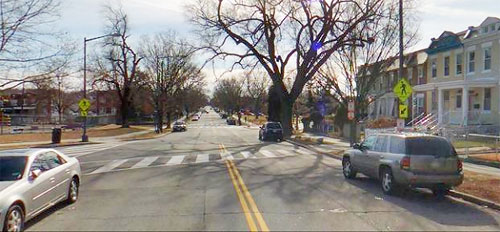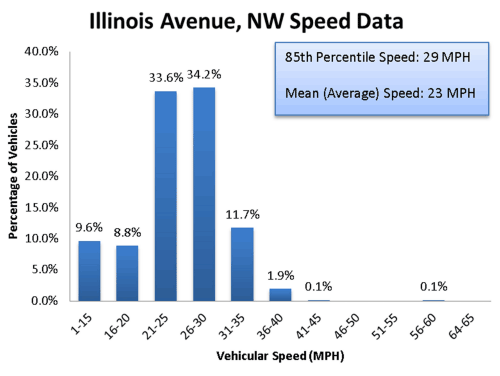Petworth residents complained drivers are speeding. DC says it’s true, but “acceptable.”
Half of drivers on Illinois Avenue in Petworth exceed the speed limit, and residents asked for traffic calming. But an analysis from the District Department of Transportation says that speeding is “acceptable.” Instead, DDOT will install signs reminding drivers to stop for pedestrians.
Responding to resident concerns, the local Advisory Neighborhood Commission, ANC 4D, passed a resolution in January, saying,
Several of these blocks of Illinois Ave. have awkward intersections leading to pedestrian safety concerns. Cars are parking within signed areas but too close to the intersections, blocking the view of crossing traffic. Additionally, the lack of stop signs on Illinois at the intersections with Emerson and Farragut Streets result in speeding traffic. When combined with the difficult visibility, the community believes this leads to unnecessary accidents[sic].
Illinois Avenue has just one driving lane in each direction and one parking lane on each side. The buildings are mostly row houses, some small apartment buildings, and small detached houses. There’s also a public school, the Truesdell Education Campus, serving children from 3 years old to eighth grade.
A team from DDOT’s Traffic Operations Administration studied the area and reviewed crash data, culminating in a report in June. The report says that from 2012 to 2014, there were 47 crashes including 19 injuries. Three of the crashes involved pedestrians and two involved bicycles.
Two of the crashes involving people not in cars happened at Farragut Street, where there is not a four-way stop or a traffic light, as the ANC resolution highlighted. The other three happened at other intersections.
The speed limit here is 25 mph, and the analysis concludes that only 52% of drivers are staying at or below that level. Another 34.2% are driving between 25 and 30 mph, while 13.8% traveling faster than that (one, it appears, clocked at 56-60 mph).
The report’s language casts this as not a problem, such as by saying that 67.8% travel below 30 mph and that the average speed was 23 mph. It concludes:
Additionally, the 85th percentile speed is within an acceptable range for the posted speed. Of note, the criteria typically employed by DDOT for installation of traffic calming measures requires the measured 85th percentile speed to substantially exceed the posted speed limit, defined as exceeding by at least 25 percent (31 miles per hour in this location). Thus, while the 85th percentile speed is 4 miles per hour above the 25 miles per hour speed limit, this measured speed does not substantially exceed the posted speed limit. (Emphasis added.)
In other words, while legally there is a rule that everyone has to travel below a certain speed, DDOT’s policy is not to take action unless at least 15% of drivers are traveling at least 25% faster.
This is the opposite of Vision Zero
Certainly, it’s fair to say that this is far from the worst street in DC for speeding or for safety. However, DC has adopted a policy called Vision Zero. The objective:
By the year 2024, Washington, DC will reach zero fatalities and serious injuries to travelers of our transportation system, through more effective use of data, education, enforcement, and engineering.
The report doesn’t say if any of the 19 injuries were serious or fatal, but the blasé attitude of the report toward speeding and 19 injuries is the polar opposite. It’s Vision Zero, not Vision Nineteen.
Remember, the chances that a driver striking a pedestrian is fatal rises from 5% to 45% as the car’s speed goes from 20 mph to 30 (and then to 85% at 40).
To eliminate — not just reduce somewhat, but eliminate — fatalities and serious injuries will require a readiness to actually make changes. A policy that nothing can be done beyond posting signs unless 15% of drivers regularly go more than 31 mph in a 25 mph zone will not achieve this.
There will be a lot of ways to improve traffic safety that don’t also slow down cars, but DDOT will have to also be willing to calm streets, and not just where speeding is egregious. A smaller residential avenue with a school, where the local ANC wants traffic calming, would be a good spot.



